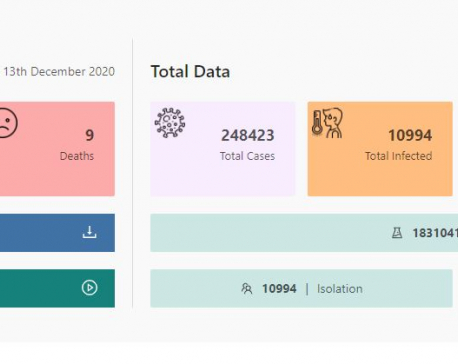
OR


Shyam Sharma
The author teaches writing and rhetoric at the State University of New York in Stony Brook. He can be reached at shyam.sharma@stonybrook.edughanashyam.sharma@stonybrook.edu
It is possible and necessary to use technology to empower and inspire, not be tyrannical. If nothing else, the harrowing global pandemic must help educators come to our senses about the overuse and misuse of authority.
When a fellow professor in a teacher training program said last month that he takes attendance twice during class since going online, I was surprised by the tyrannical idea. What if a student lost internet connection or electricity, ran out of data or was sharing a device, had family obligations or a health problem? We’re not just “going online,” we’re also going through a horrifying global pandemic!
At a workshop on “humanizing pedagogy” for a Bangladeshi university more recently, when asked to list teaching/learning difficulties now, many participants listed challenges due to student absence, disengagement, dishonesty, and expectation of easy grades. When asked to list instructional solutions, many proposed technocratic and rather authoritarian methods. The very system of our education, I realized, is tyrannical and most of us usually try to make it work as it is.
Tyranny, now aided by technology, goes beyond formal education. “You can only fill your bucket if you’ve brought it empty,” said a young yoga instructor in Kathmandu, on Zoom last week. She kept demanding, by name, that participants turned on their video feed. We kept turning it off as needed. Someone kept individually “spotlighting” us on screen. But we were always muted, even as we were constantly asked to respond to instructor questions by chat, thumbs up, hand wave, and smile. Technology magnified autocratic tendencies, undermining the solemnity of yoga.
The quality of yoga lectures and instruction didn’t match the technologically enforced discipline. “Our lungs remove ninety percent of toxins from our body,” said an instructor. Surya namaskar fixes both overweight and underweight, said another, as well as cancer and diabetes. Googling these claims led to junk websites. I quickly became an unengaged learner, waiting for lectures to be over. I read a book on yoga during lectures, or took notes on how technology can magnify tyrannical elements of instruction and academe. I reflected on how to make my own teaching more humane.
This essay is a broader commentary on the element of tyranny in education. But to show that the idea of making teaching more humane is not just a romantic ideal, I share how we can operationalize the concept, including and especially during this disrupted time.
Operationalizing humanity
The first step to developing more humane teaching is to mind, deeply, the difficulties we know and can imagine our students facing, from physical to social to psychological. To be “effective” educators now, we must stop being oblivious to the pandemonium created by a pandemic when designing curriculum and pedagogy, seeking quality and rigor, reviewing assessment and outcomes.
Start by assessing the situation, using a survey. Include questions about: students’ location and health situation, any disruption due to family or community, reliability of electricity, quality and cost of internet connection (wifi or cellular data), type and capacity of computer used (or if only a tablet or phone is available), whether the device is shared with family members, availability of hardware and software required, level of technological skills, access to books and other materials, ability to complete coursework on time, and anything else students may want to share. This involvement can enhance trust, feeling of belongingness, ownership of learning, and sense of agency.
Create guidelines for effective learning, including how to use technology productively, drawing on the survey. Discuss the guidelines, inspiringly, to begin the session; update them along the way. Rules appreciated, and not imposed, evoke respect and foster engagement. Within institutional and departmental mandates, lower workload in course planning, making deadlines flexible and encouraging students to reach out for extension and accommodations as needed.
To address disruption—and unequal access—to internet connection, design course, activities, and assignments with absentees and disruption in mind. Combine synchronous and asynchronous methods to maximize access and learning. Record and post lectures on course site. Ask students to write a brief summary and response to class recording to make up for absence, making absence less appealing as a choice. But excuse a few absences, and more when justified. Share slides, with notes, and additional resources, also asking students to share class notes for absent classmates.
To shift focus from “attendance” to “engagement,” allocate more credit for activities, interactions, assignments, and collaboration. Make them more student-centered (not less). Reward participation and contribution with grade and feedback. Break monotony with breaks, stretching, and humor. Consider teaching by standing (and see how it shifts dynamics). Fill class time with more active learning than active teaching.
Don’t compensate for physical presence and body language by becoming a technocrat or autocrat. Ask students to use video whenever possible. Give time when they talk, encourage response to each other, and allow them to share screen. Use drawing, integrate multimodal resources, feedback tools (polls, thumbs up, clap, hand raise, etc) during discussion. Give students time to write their thoughts before asking them to speak or work in groups.
When teaching asynchronously, create presence with regular messages, individualized and general response, video and multimodal resources, and cloud-based collaboration tools. Use voice typing to provide more substantive feedback (eg, on Google Doc), making feedback more positive/constructive. Reward credit for, and personally respond to, forum discussions—as well as peer feedback on assignments. Assign group projects and presentations, using group tools or manually creating groups. Maintain virtual office hours, offering individual appointments.
Teaching with trust
Trust is critical to effective teaching. Defaulting assumption to dishonesty and disinterest can ironically create them. Students who understand and appreciate the value of a course and assignment are more motivated to perform better.
So, for instance, to prevent plagiarism, address its causes: lack of time or time management skills, stress or fear of failure, gap between ability and aspiration or teacher demand, cost of education, and so on. To make plagiarizing less easy and appealing, require integration of class readings, pose new questions and unique demands every time, ask students to use surveys or interviews with classmates, and ask for a written reflection with the assignment. Ask students to submit process materials: outline, draft, revision, and edited versions, using apps like Google Doc to reward the process.
Match students’ efforts with your support in the process. Provide samples, discuss and analyze them, and let students emulate good strategies. Boost confidence and trust in you as a mentor, so you’re not the teacher who receives plagiarized papers.
Technology can be used to help prevent plagiarism, such as showing how and how much to cite. Don’t use it to replace your judgment. No application detects all forms of academic dishonesty: cheating, fabrication, falsification, ghost writing, multiple submission, complicity/collaboration, etc. Note that depending on “detection” tools can reflect a lack of effective pedagogy, understanding, motivation, trust of students, empathy. Professional ethics and responsibility toward student rights demand that we not force them to surrender their intellectual property to help third parties make a buck.
If summative exams are necessary, encourage students to seek support when tech goes wrong during exams. Drop the worst grade, especially if it was impossible for a student to complete the task.
Looking in the mirror
How we teach, assess and treat students and their work reveals much about us. The whole point of education is to inspire, not control. It is to foster agency, not fear. We must stop insisting (with our actions) that without control and fear, we can’t be so sure that students are learning (as did my yoga course).
This insistence on control doesn’t come from the fact that our students are dishonest, uninterested, or ignorant about the value of education. It comes from a lack of confidence in our own ability to engage them without using methods of control, tools for surveillance, tests overshadowing teaching, distrust dominating the entire landscape of education. It also comes from a deficit of what it takes to engage and inspire: continued learning and research, deep study and preparation, respect and trust.
We do talk about humanizing, as an ideal, but we default practice to control and command, demand and suspicion. Our system rewards grades and therefore cheating to increase them, and we are angry that students are only there for the grade, that they will cheat us. We doubt and dominate, and we assume that they are inherently dishonest. We monitor and surveil constantly, and we want them to freely desire and be inspired by learning for its own sake.
The pandemic is not only exposing bad pedagogies. If we pause to see how the current situation is magnifying unequal life situations and power relations between people, we could also start encountering faultlines in our institutions in normal times. We would more clearly see new cracks in otherwise solid educational structures.
It is possible and necessary to use technology to empower and inspire, not be tyrannical. If nothing else, the harrowing global pandemic must help educators come to our senses about the overuse and misuse of authority.
It is time to take tyranny out of teaching, using humane approaches instead. Doing so will make our students stop waiting for the second attendance and start learning.
You May Like This

Nepal's COVID-19 update: 830 new cases, 1,500 recoveries and nine deaths in past 24 hours
KATHMANDU, Dec 13: Nepal recorded 830 new cases, 1,500 recoveries and nine deaths linked with the novel coronavirus disease (COVID-19)... Read More...

Russia plans COVID-19 vaccine output at 6 million doses a month - RIA
MOSCOW, Aug 24: Russia expects to produce between 1.5 million and 2 million doses per month of its potential COVID-19... Read More...

PM Oli, President of Israel hold telephone conversation, discuss measures to tackle coronavirus
KATHMANDU, May 1: Prime Minister K P Sharma Oli and President of the State of Israel Reuven Rivlin discussed the... Read More...







Just In
- NRB to provide collateral-free loans to foreign employment seekers
- NEB to publish Grade 12 results next week
- Body handover begins; Relatives remain dissatisfied with insurance, compensation amount
- NC defers its plan to join Koshi govt
- NRB to review microfinance loan interest rate
- 134 dead in floods and landslides since onset of monsoon this year
- Mahakali Irrigation Project sees only 22 percent physical progress in 18 years
- Singapore now holds world's most powerful passport; Nepal stays at 98th











Leave A Comment